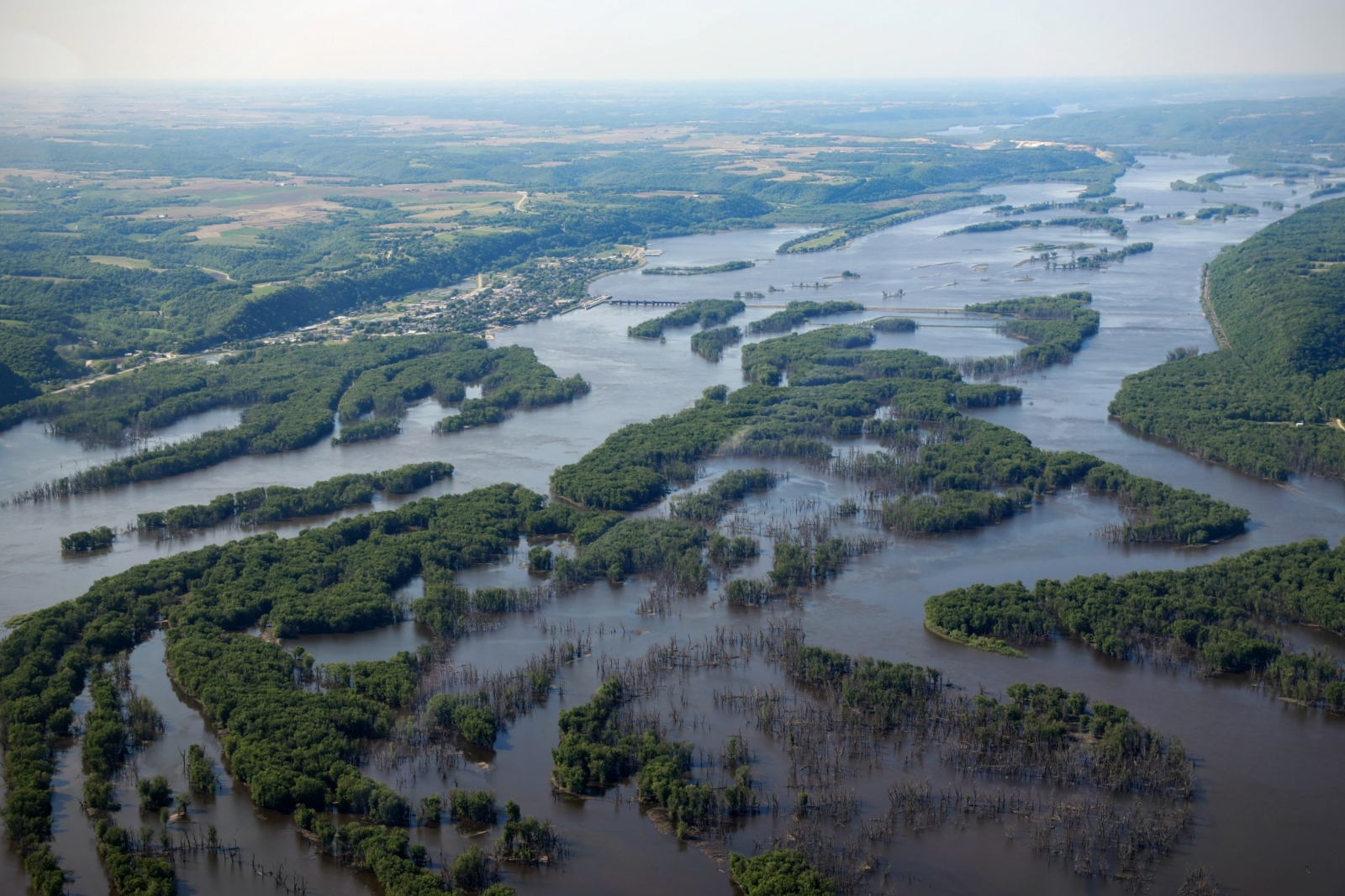This story was originally published by WNIJ and is republished with permission.
The Mississippi River flowed lazily under the Centennial Bridge, which connects Illinois and Iowa in the Quad Cities. Cars cruised past on a Saturday afternoon in early May, waving and occasionally honking at a long line of environmentalists who say the river is alive.
Glenda Guster was among the roughly 80 people to join the Great Plains Action Society’s Walk for River Rights — the centerpiece of a three-day summit earlier this month for Black and indigenous organizers from across the Mississippi River basin, who, among other things, want to grant the river legal standing.
Like many making the march across the river, Guster, who held a sign saying “water is life” over her head, said the river needs more protection.
“The river has rights, just like human rights,” said Guster. “Nature has rights and it’s up to us to preserve these rights.”
According to Sikowis Nobis, the founder of the indigenous rights organization, the goal of the summit was to build a riverwide coalition to rethink the legal framework they believe imperils life on and in the Mississippi River. The way she sees it, the existing legal system cannot confront the types of environmental disasters that are increasingly imminent – but “Rights of Nature” might.
The idea is that natural entities like rivers, trees and wildlife have the same rights as humans and thus have legal standing in a court of law. Natural entities, the legal principle holds, constitute living beings with legally enforceable rights to exist that transcend the category of property.

“The earth is really suffering, and rights of nature would basically give personhood to the river,” said Nobis. “It would allow us to have more power to keep it safe.”
The legal movement to grant natural entities like forests and rivers the same legal rights as humans has won meaningful success abroad, and has in recent years picked up steam in the United States. Largely indigenous-led campaigns to recognize the legal rights of natural entities like wild rice in Minnesota, salmon in Washington, and the Klamath River in northern California are setting the stage for a nascent movement for the Mississippi River.
The implications of rights of nature as a legal instrument are far reaching. Companies could be taken to court for damaging ecosystems, and construction projects with the potential to cause environmental damage could be stopped.
That’s exactly what happened in Tamaqua, a small town in Pennsylvania. Thomas Linzey is a senior attorney at the Center for Democratic and Environmental Rights and drafted the document to grant the small borough rights.
“It may be a radical concept, or it was 20 years ago, but we’re rapidly coming to a place where without this kind of new system of environmental law, we’re all kind of done, we’re kind of cooked,” said Linzey.
Ultimately, locals were able to stop sewage sludge from being dumped in Tamaqua using the new ordinance.
Linzey said that before the rights of nature movement made its way into the mainstream, it was born from the cosmologies of indigenous people that recognized the natural world as made up of living beings – not just resources or commodities.
In 2008, Linzey consulted the Ecuadorian government while it drafted its new constitution, the first in the world to ratify the Rights of Nature. In 2021, an Ecuadorian municipality appealed to the constitutional protections to overturn mining permits that they said violated the rights of nature of the endangered Los Cedros rainforest.
“The work has spread to other countries, and in the U.S. to about over three dozen municipalities at this point,” said Linzey.
Ecuador remains the only country in the world to enshrine the rights of nature in its constitution. A similar proposal was considered in Chile last year, and the island nation of Aruba is currently reviewing its own amendment addressing the inherent rights of nature. Court decisions in countries like Bangladesh, Colombia and Uganda have successfully held up the rights of nature. Local laws and treaty agreements recognizing the rights of nature are emerging across the globe, particularly in the U.S.
Lance Foster, a member of the Iowa Tribe of Kansas and Nebraska and a speaker at the Mississippi River Summit, said that a couple years ago, the success of rights of nature in South America got his and other tribes thinking, why not us?
“And we wondered why haven’t the big rivers, like the Missouri River, and the Mississippi River, gotten those rights?” said Foster.

He said his tribe and others have created an inter-tribal resolution for the rights of the Missouri River. They hope to use it to fight industrial scale agriculture and deep mining operations.
“If the Mississippi had those rights recognized… it would be able to have standing in court for an advocate on its behalf to help clean it up,” said Foster.
Two years ago in Minnesota, the White Earth Band of Ojibwe brought a suit against the Enbridge corporation’s Line 3 on behalf of wild rice, called Manoomin. And last month, the city of Seattle settled a case with the Sauk-Suiattle Indian Tribe over the claim that salmon had the right to spawn, among other rights.
Because the Mississippi and Missouri rivers flow through so many states and tribal lands, experts said it would be prohibitively complicated to secure legal standing for them in the courts.
But Foster said if corporations get legal rights in the U.S., why shouldn’t rivers? Afterall, they were here far before humans.
States like Idaho, Florida and Ohio have moved to preemptively ban the possibility that nature or ecosystems can have legal standing. Even so, Foster said the rights of nature isn’t as unthinkable as it once was. After all, children, women, Black and indigenous people were denied rights once too – what’s stopping the river.
“It gives us a chance,” said Foster. “Now, will we take that chance as a society? I’m dubious most days, but we have to keep trying, we have to keep going to the bitter end.”
This story is a product of the Mississippi River Basin Ag & Water Desk, an editorially independent reporting network based at the University of Missouri School of Journalism in partnership with Report For America and the Society of Environmental Journalists, funded by the Walton Family Foundation.

